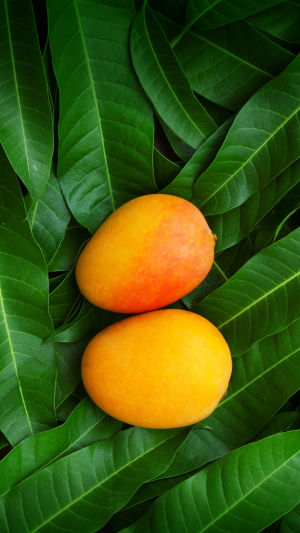The mango, the king of tropical fruits, is widely praised for its delicious taste, bright color, and strong aroma. It is extremely popular in tropical and subtropical regions around the world.
Mangoes belong to the Anacardiaceae family, which also includes cashews and pistachios.
The mango tree is an evergreen tree that can grow up to 100 feet tall with a dense canopy of rounded dark green leaves. It bears fruit after a few years of growth, and each tree produces copious amounts of mangoes throughout its lifetime. The fruit itself is large, and oval in shape, has thick skin, and varies in color from green to various shades of yellow, red, or orange, depending on the variety.
The inner pulp is juicy and juicy, ranging in color from golden yellow to deep orange. The taste of ripe mangoes is sweet and tangy and is often described as the perfect balance of tropical flavors like citrus, peach, and pineapple.
Mangoes are not only loved for their delicious taste but also valued for their nutritional value. They are rich in vitamins, especially vitamin C and vitamin A, as well as dietary fiber and antioxidants. In addition, mangoes contain various minerals such as potassium and magnesium, which are essential for maintaining a healthy body.
This tropical fruit has been cultivated for thousands of years and has a long cultural significance in many countries. It is said to have originated in South Asia, especially India, and Myanmar, where it has been cultivated for over 4,000 years. From there, mangoes spread around the world through trade and exploration.
Today, mangoes are grown in many countries with suitable climates, including India, Mexico, Thailand, the Philippines, Brazil, etc. They are fresh and can be used in a variety of culinary preparations such as smoothies, salads, salsas, desserts, and even added to savory dishes.
Not only is the mango a delicious fruit, but it has also influenced the art, literature, and cultural traditions of the regions where it thrives. Mango-themed festivals and celebrations are held around the world, highlighting the cultural significance and devotion to this tropical treasure.
Overall, mangoes are loved for their taste, nutritional value, and cultural importance. Their unique flavor and versatility make them a delightful addition to numerous culinary creations, while their wealth of health benefits ensures they remain a popular choice for fruit lovers worldwide.
But like any other fruit or food, mango preferences vary from person to person due to several factors. Why do some people not like it?
1. Taste Sensitivity: Everyone has unique taste preferences and sensitivities. The sweet and sour taste of mango may appeal to some taste buds, while others may find it too strong or overwhelming.
2. Texture preference: Mangoes have a unique texture, ranging from firm and fibrous to soft and juicy, depending on the variety and ripeness. Some people like the smooth and creamy texture of a ripe mango, while others may not like the pulp or fiber content.
3. Allergies: Allergies to mangoes can affect personal preference. Due to the presence of certain compounds, some people may experience allergic reactions or oral irritation, such as itching or tingling in the mouth, when consuming mangoes. This can lead to an aversion to mangoes or a conscious decision to avoid mangoes.
4. Cultural and culinary background: Mangoes have great cultural significance in many countries and are widely used in various traditional dishes and dishes. People who grew up in a mango culture may develop a strong affinity for mangoes. Conversely, those who did not grow up with mangoes may not develop an interest in them.
It's important to remember that taste preferences are highly subjective, and what appeals to one person may not appeal to another. The diversity of preferences makes the culinary world fascinating as different flavors and tastes cater to a wide range of palates.





